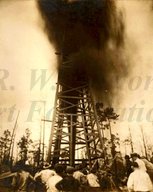
|

|
|
|
|
This entrepreneur in the Louisiana oil and gas industry is a native of Vivian, Louisiana. "Stan," as friends call him, is the son of Wallace A. Stanberry and Guffie Azalee Burney Stanberry. Although he shares the name with his father he is not a junior. While the family was living at Corpus Christi, Texas, his father, a driller for Kelly Oil Company, died in a work-related accident. Young Stanberry grew up in the homes of his maternal grandparents, S.B. Burney, an oil industry pioneer, and Maude Burney. Because the family moved for his grandfather's work in oil boom areas, Wallace attended six different schools. "He had eighteen or twenty rigs, and when I wasn't in school, I'd make the rounds with him," he recalls of his grandfather, a partner in Hubbard Drilling Company. While on drilling sites, Stan gathered empty milk bottles roughnecks had tossed into the brush. Finding as many as twenty-five or thirty a day, he returned them for the nickel deposit on each bottle. "I learned to be an entrepreneur like that," he says. Stan served in the U.S. Navy in World War II as an aircraft gunner aboard the USS Savannah (CL-42) and the USS Baltimore (CA-68). He married Dorothy Howell on September 27, 1944. (They would have two sons). Discharged in September of 1945, he began working as a roughneck for his father-in-law, Tommy Howell. Taking advantage of the GI Bill, Stan enrolled at Louisiana State University, where he attended class by day and toiled in the oilfields at night for twenty-five cents an hour. "Hard work, dirty work," he recalls of roughnecking. Within three years, he graduated with a degree in petroleum engineering in 1949, having received credit for military service and "some of the things I learned in the navy." Stan worked briefly for Arkansas Fuel in Shreveport, then was hired at Gulf Oil Company in Laurel, Mississippi. He worked in the core laboratory, then as a roustabout at Baxterville, Mississippi. "After then they promoted me and I got a raise and a company car," he says. Still, he was making less than roustabouts, who worked a forty-hour week. Engineers were expected to be on the job, seven days a week, twenty-four hours a day, if needed. He calls his ten-year tenure as an engineer with Gulf his "post-graduate work." He turned down posts to foreign fields, then was transferred to district headquarters of Gulf Refining Company in Shreveport. He recalls that the first oil well in water was drilled in Caddo Lake, where 247 wells eventually would produce from shallow oil. Stan created drilling barges to "drill off a barge and move on." He worked in the laboratory in Pittsburg, then was tabbed for higher management and sent to Buras, Louisiana, seventy miles south of New Orleans. There he served as Area Drill Engineer in charge of a drilling engineer, twenty drill foremen, and fifteen to thirty rigs that were producing 50,000 barrels a day--all within about twenty miles of his office. After learning his men were drilling deep wells with standard red mud costing fifteen dollars a foot, Stan introduced jet mud and reduced drilling costs to three dollars a foot. Refusing a promotion to a headquarters office in New Orleans, he left Gulf and returned to Shreveport. With a partner, Coon Barnett of Vivian, he developed a small field near Natchitoches. He then opened his own business in downtown Shreveport, Stanberry Oil Company, which he was determined to run as an enterprise based on Christian ethics. In the 1970s, he teamed with a chemist, P.C. Dobie Keith of Denton, Texas, to use CO[2] to enhance oil recovery. With it, the partners recovered a half million barrels of oil from the Ritchie Field in southern Arkansas. They recovered one barrel of oil for one MCF (a thousand cubic feet) of CO[2]. "Most of the majors spend eight or ten or twelve MCF's per barrel," he says. Stan is convinced that two-thirds of discovered oil remains in the ground. "With natural fluid expansion and gas energy you can get twelve to fifteen per cent," he remarks. "You can get another twelve to fifteen per cent if there's some water coming in that maintains the pressure or helps move it. Or you can put water in it and sometimes you may get recovery up to forty per cent. But typically, about a third is all you get. With CO[2], you can double that." He spent a frustrating two-and-a-half years in the late 1970s putting together a project to recover oil from two depleted fields in the Texas panhandle. (His son, Lynn, by then was working with him.) One day while flying to Houston, he recalls, he said aloud, "Lord, our business belongs to you." Soon, the project was realized and he eventually recovered over five million barrels of oil from those two depleted fields. His example spurred major oil companies, who originally were skeptical of using CO[2] in oil recovery. "Half the industry thought I was crazy, and the other half was sure I was crazy," he quips. While Stan likes "alternate" sources of energy, including solar, wind, and nuclear, he doesn't believe technology has yet solved nuclear waste problems. He calls CO[2] "not a `toxic gas.' Every human and mammal breathes it out constantly," he says. He believes global warming and cooling periods are natural and are not man-made. He also is enthusiastic about the gasification of coal into a syngas. In his career, however, he said he drilled only one well on his own, and it was a dry hole. Stan is active in mission work, and serves as president of Abundant Life Ministries in Honduras. Note: In another interview, Mr. Stanberry discusses his youth and war record. It may be found at OH-51. |


